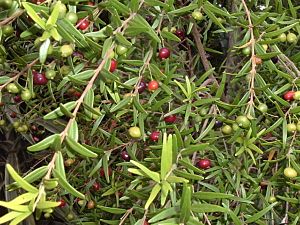Eugenia facts for kids
Quick facts for kids Eugenia |
|
|---|---|
 |
|
| Eugenia sprengelii | |
| Scientific classification |
|
| Kingdom: | Plantae |
| Clade: | Tracheophytes |
| Clade: | Angiosperms |
| Clade: | Eudicots |
| Clade: | Rosids |
| Order: | Myrtales |
| Family: | Myrtaceae |
| Subfamily: | Myrtoideae |
| Tribe: | Myrteae |
| Genus: | Eugenia P.Micheli ex L. |
| Type species | |
| Eugenia uniflora |
|
| Species | |
|
Over 1,100; see List of Eugenia species |
|
| Synonyms | |
|
List
|
|
Eugenia is a large group of flowering plants. They belong to the myrtle family, called Myrtaceae. These plants grow all over the world in warm, tropical, and subtropical areas.
Most of the over 1,100 different kinds, or species, of Eugenia are found in the New World tropics. This includes places like the northern Andes mountains, the Caribbean islands, and the Atlantic Forest along the coast of eastern Brazil. Other places with many Eugenia species are New Caledonia and Madagascar. Many species that used to be called Eugenia in the Old World (like Asia and Africa) are now part of a different group called Syzygium.
All Eugenia species are trees and shrubs that stay green all year round. Some are grown as pretty garden plants because of their shiny leaves. A few kinds also grow tasty fruits. People eat these fruits fresh or use them to make jams and jellies.
About Eugenia Plants
The name Eugenia was given to these plants to honor Prince Eugene of Savoy.
Scientists are still finding and describing many new species of Eugenia. For example, 37 new species have been found in Mesoamerica in recent years. About 20 new species are being described from New Caledonia, and a similar number might be found in Madagascar.
Even though the myrtle family is very important in Australia (with famous plants like Eucalyptus), only one Eugenia species, E. reinwardtiana, grows there. There are also some Eugenia plants in Africa, but not as many different kinds.
For a while, some plant scientists thought the similar-looking Syzygium plants from the Old World were part of Eugenia. But research in the 1970s showed that they are actually different groups. More recent studies using DNA information have helped scientists sort out the Eugenia group even more. Some species that were once in Eugenia have moved to Syzygium or Pimenta. Also, some smaller groups from the Caribbean and India were found to be part of Eugenia.
Popular Eugenia Species
There are many different kinds of Eugenia plants. Here are a few examples:
- Eugenia brasiliensis – This plant is known as grumichama and grows in Brazil.
- Eugenia calycina – Also called savannah cherry.
- Eugenia involucrata – Known as cherry of the Rio Grande.
- Eugenia luschnathiana – Called Bahia pitomba, found in Bahia, Brazil.
- Eugenia pyriformis – This Brazilian plant is known as uvaia.
- Eugenia reinwardtiana – Called mountain stopper or Cedar Bay cherry. It grows in Queensland, Australia, Indonesia, and Pacific Islands.
- Eugenia stipitata – Known as arazá-boi, found in the Amazon Rainforest.
- Eugenia uniflora – This is the Suriname cherry or pitanga, common in the Neotropics.
Life Cycle and Ecology
Eugenia plants are sometimes eaten by the young forms (called larvae) of certain moths. These include some hepialid moths from the Aenetus and Endoclita groups. For example, A. splendens larvae dig tunnels into the tree trunks. Other moth larvae, like Eupseudosoma aberrans, also feed on Eugenia plants.
See also
 In Spanish: Eugenia (planta) para niños
In Spanish: Eugenia (planta) para niños

